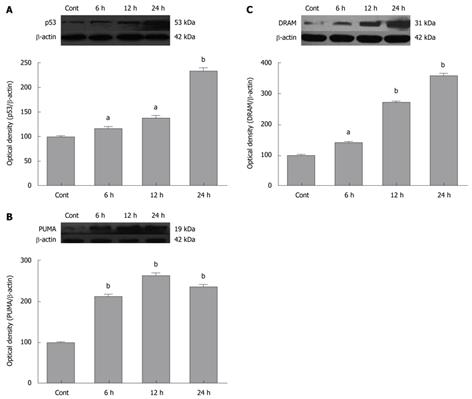Copyright
©2011 Baishideng Publishing Group Co.
World J Gastroenterol. Jan 28, 2011; 17(4): 478-487
Published online Jan 28, 2011. doi: 10.3748/wjg.v17.i4.478
Published online Jan 28, 2011. doi: 10.3748/wjg.v17.i4.478
Figure 2 Blocking nuclear factor-κB nuclear translocation induces p53 and its target proteins.
A: Western blotting analysis of p53 of the control and SN50-treated SGC7901 cells. Western blotting analysis was used to detect the protein levels of p53 after SN50 treatment for 6-24 h. SGC7901 cells were treated with SN50 (18 μmol/L) and were harvested for total proteins. It indicates that SN50 may up-regulate the expression of p53. Values were given as mean ± SD. Statistical comparisons were carried out with Dennett’s test. aP < 0.05 and bP < 0.01 vs control (n = 3); B: Western blotting analysis of P53 upregulated modulator of apoptosis (PUMA) of the control and SN50-treated SGC7901 cells. Western blotting analysis was used to detect the protein levels of PUMA after SN50 treatment for 6-24 h. SGC7901 cells were treated with SN50 (18 μmol/L) and were harvested for total proteins. It indicates that SN50 may up-regulate the expression of PUMA. Values were given as mean ± SD. Statistical comparisons were carried out with Dennett’s test. bP < 0.01 vs control (n = 3); C: Western blotting analysis of damage-regulated autophagy modulator (DRAM) of the control and SN50-treated SGC7901 cells. Western blotting analysis was used to detect the protein levels of DRAM after SN50 treatment for 6-24 h. SGC7901 cells were treated with SN50 (18 μmol/L) and were harvested for total proteins. It indicates that SN50 may up-regulate the expression of DRAM. Values were given as mean ± SD. Statistical comparisons were carried out with Dennett’s test. aP < 0.05 and bP < 0.01 vs control (n = 3).
- Citation: Zhu BS, Xing CG, Lin F, Fan XQ, Zhao K, Qin ZH. Blocking NF-κB nuclear translocation leads to p53-related autophagy activation and cell apoptosis. World J Gastroenterol 2011; 17(4): 478-487
- URL: https://www.wjgnet.com/1007-9327/full/v17/i4/478.htm
- DOI: https://dx.doi.org/10.3748/wjg.v17.i4.478









